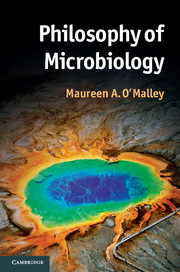Book contents
- Frontmatter
- Contents
- List of figures and tables
- Acknowledgements
- An introduction to philosophy of microbiology
- Chapter 1 Philosophy in microbiology; microbes in philosophy
- Chapter 2 Philosophical debates in high-level microbial classification
- Chapter 3 Philosophical debates in species-level microbial classification
- Chapter 4 Philosophical issues in microbial evolution
- Chapter 5 Microbial ecology from a philosophical perspective
- Chapter 6 Microbes as model biological systems
- Conclusion: further philosophical questions
- Glossary
- References
- Index
Chapter 5 - Microbial ecology from a philosophical perspective
Published online by Cambridge University Press: 05 September 2014
- Frontmatter
- Contents
- List of figures and tables
- Acknowledgements
- An introduction to philosophy of microbiology
- Chapter 1 Philosophy in microbiology; microbes in philosophy
- Chapter 2 Philosophical debates in high-level microbial classification
- Chapter 3 Philosophical debates in species-level microbial classification
- Chapter 4 Philosophical issues in microbial evolution
- Chapter 5 Microbial ecology from a philosophical perspective
- Chapter 6 Microbes as model biological systems
- Conclusion: further philosophical questions
- Glossary
- References
- Index
Summary
Microbial ecology until recently was a minor stream of microbiology. Molecular innovations have now pushed the field to the forefront of microbiological research. At the same time, these methods have generated a whole raft of conceptual issues about microbial biodiversity. These are not simply questions of how many microbial species there are, but more basic ones about whether taxa are the entities that should be the units of analysis or whether functionally interacting groups are more appropriate. Communities and ecosystems are increasingly the object of attention in microbial ecology. Analyses at these levels raise further questions about whether concepts of organism, multicellularity and reproduction should be understood in dependence on animal-based notions. Likewise, models of the distribution of microbial biodiversity and community assembly have been borrowed from large-organism ecology, but their application in microbial ecology suggests new approaches to macrobial ecology.
A brief history of microbial ecology
Most histories of microbiology do not emphasize ecological perspectives. This is at least in part because of the emphasis on laboratory-based pure culture methods and the medical applications of microbiology. However, in the early days of microbiology, when taxonomic efforts dominated, many systematists had no choice but to gather their organisms from environmental sites and even study them there, since laboratory cultures did not exist. For example, Ehrenberg – the taxonomist mentioned in Chapter 3 – collected or was sent samples from the Red Sea, the Rocky Mountains in the United States and a great variety of other aquatic and terrestrial sites (Ehrenberg 1838; O’Malley 2007). Later, as the pure culture method rose to prominence, a few microbiologists augmented their laboratory work with techniques that approximated environmental conditions. They also laid more explicit foundations for microbial ecology. These researchers argued that making ‘controlled’ approximations of natural environments was a rigorous scientific strategy that would deliver more knowledge than pure culture could (Stanier 1951).
- Type
- Chapter
- Information
- Philosophy of Microbiology , pp. 132 - 172Publisher: Cambridge University PressPrint publication year: 2014
- 1
- Cited by

